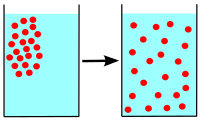
Photo from wikipedia
Abstract New emission legislation requires number concentration measurements of particles emitted by passenger cars during periodic technical inspections (PTI). For PTI suitable instruments are needed to detect faults, such as… Click to show full abstract
Abstract New emission legislation requires number concentration measurements of particles emitted by passenger cars during periodic technical inspections (PTI). For PTI suitable instruments are needed to detect faults, such as diesel particulate filter failures. Diffusion charging is well established as a charging method for particle sensors and is suited to realize low-cost instruments for exhaust particle number measurements in the appropriate size and concentration regime. In order to manufacture affordable instruments, sensors should not only be low cost, but their calibration procedure must be simple and reliable. We experimentally investigated the impact of test aerosol properties—such as material, size, concentration and morphology—on the counting efficiency of two pulsed-mode, unipolar diffusion charging approaches: (i) conventional diffusion charging and (ii) modulated precipitation. By separately characterizing the particle charging process and the overall sensor response with different test aerosols, we found that the modulated precipitation principle shows a very good correlation to particle number concentration, although the method significantly depends on the particle morphology. The conventional approach is not well suited for particle number measurements due to its intrinsic dependency on particle size. We demonstrate that the counting efficiency of the modulated precipitation configuration measured with different tests aerosols stays within 3% for particle sizes up to 80 nm. The difference between a calibration with soot and salt particles with respect to the total solid particle number concentration was estimated to be smaller than 11%. Thus, a calibration according to recently introduced PTI legislation with any of the test aerosols considered is feasible. Tailpipe measurements confirmed the applicability of the modulated precipitation configuration for PTI. As a consequence, the use of diffusion charging based instruments in periodic inspections seems to be suitable due to appropriate sensor response and the simplicity of the calibration process. Copyright © 2020 American Association for Aerosol Research
Journal Title: Aerosol Science and Technology
Year Published: 2020
Link to full text (if available)
Share on Social Media: Sign Up to like & get
recommendations!